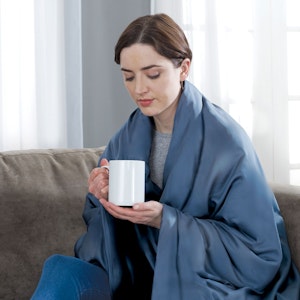As summer heat gives way to cooler autumn nights, you may struggle to get a good night’s sleep as you try to find the most comfortable temperature to fall and stay asleep.
During the transition from one season to the next, bedtime can feel like a nightly battle between your body’s natural temperature regulation, the room temperature, your bedding choices. And not to mention what your sleep partner finds comfortable may not match your preferences.
Before we offer our three easy strategies to win that battle (except the one with your partner), here’s a quick primer on how our bodies regulate sleep and wakefulness: Body temperature works to help circadian rhythms, i.e. our body’s clock, to stay in sync with day and night activities. As we move towards sleep, our body temperature begins to fall and continues dropping as we enter deep sleep. By contrast, as we move towards wakefulness, typically around 4 to 5 a.m., body temperature begins to rise.
1. Preparing for good sleep starts way before bedtime.
Helping our body temperature move in the right direction at night necessitates taking control of exercise timing during the day and sleep-wise activities leading up to bedtime. Maintaining a mild 65 to 70-degree temperature in your bedroom also plays an important role in ensuring a good night’s sleep.

Exercise fatigues muscles, helps us fall asleep easily. When should you schedule strenuous activity? The optimum time to work out is during the morning. Should this not be possible, schedule your exercise to conclude no later than 7 p.m., thereby giving your body time to slow and cool down before you sleep.
Ironically, taking a warm bath before bed can help you cool down. Neuroscientists Harding, Franks and Wisden note in their article, The Temperature Dependence of Sleep, that warming the skin helps us begin sleep sooner. Warmth activates body circuits to cool our cores into a satisfying deep sleep. A helpful analogy is how a hard workout makes you sweat, and sweat then cools you off.
2. Breathable bedding is for cool sleepers.
Choose breathable bedding and stay away from synthetics. Polyester may heat you up while cotton, linen and wool let in air so your body temperature remains consistent. Consider natural fibers which wick away sweat. Cotton flannel sheet sets bring coziness to your sleep experience. Weighted cooling blankets create a relaxing embrace to soothe you towards sleep.

3. Choose pillows and mattress toppers that cool and support you.
Do you need a supportive cool while sleeping? Body pillows made with cooling technology can provide luxurious length for support where you need it as well as temperature balance by cooling you through the night. Similarly, mattress pads and toppers also help regulate your sleep temperature. A memory foam mattress topper pulls excessive heat from the bed’s surface to prevent overheating. As your temperature lowers, the stored heat releases to the surface to warm you up.
Breathe in the beauty of fall color after a good night’s sleep. Help yourself by preparing your body to sleep well, creating a temperature-neutral bedroom, and outfitting your bed with comfy temperature regulating options.

